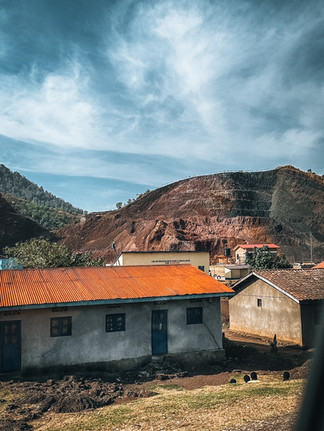Gorilla Trekking in DRC via Rwanda: A Soulful Solo Journey into Africa's Untamed Wild
- Ankitha
- Oct 5, 2023
- 6 min read
Updated: Aug 12
In the depths of my soul-stirring wanderlust, I found myself irresistibly drawn to a destination shrouded in complexity and enigma—a place long misunderstood, often called the heart of darkness. But behind the headlines, the Democratic Republic of Congo (DRC) reveals itself as one of the most underrated trekking destinations in the world, rich with raw nature, resilient people, and unforgettable wildlife.

My second adventure of August 2023 was a solo trip to Rwanda and DRC. Most of my travels are offbeat—chosen because they challenge, move, and transform me. I crave that slight discomfort, that shift from the everyday into the unknown. This was one of those journeys.
In this ultimate travel blog for gorilla trekking in DRC, I’ll share practical tips, the realities of solo travel in Africa, and my emotional journey through a complex, beautiful land.

Itinerary
Day 1: Arrive in Kigali, Rwanda. Explore the city.
Day 2: Drive to Nyungwe. Overnight in a border town.
Day 3: Cross the Rwanda-Congo border. Gorilla Trekking in Kahuzi Biega National Park.
Day 4: Tchegera Island escape.
Day 5: Goma – visit refugee communities and local NGOs.
Day 6: Cross back into Rwanda and fly out.
TABLE OF CONTENTS
Flights + Visa for Congo
Fly into Kigali—Rwanda to Congo border crossings are easy with the right documents. For Indian passport holders, gorilla trekking visas for DRC can be arranged for $100 with an invitation letter from a local agency. Visiting other regions of DRC? Then the DRC embassy visa is required (~$200), which takes longer.
Language
English is widely spoken in Rwanda. In Democratic Republic of Congo, French dominates. Have Google Translate ready!
Best Time to Visit
Dry seasons: June–September and December–February. These are ideal for gorilla trekking in DRC and travel across Central Africa.
Currency
Rwanda: Card-friendly. Congo: Use Congolese Franc. USD accepted, but bills under $5 are refused.
Where I Stayed
I stayed at budget-friendly backpacker lodges near the Bukavu border. Comfortable, simple, and perfect for backpacking in Africa solo.

Getting Around Rwanda
Rwanda is incredibly safe and well-paved. I recommend hiring a car or a local driver. I chose a reliable guide for my journey.
Costs + Local Guide in DRC
For DRC, I traveled with Romuald from Ubuntu Voyages. Honest, flexible, and well-connected—highly recommended!
Expect to pay $1500+ for a 5-6 day trip including gorilla permits, visa processing, basic stays, and food. Solo travel in Africa, especially in DRC, isn’t cheap—but it’s deeply enriching.
Safety for Solo Travel in DRC
Safety in DRC for tourists is complex. While parts of the country remain volatile, the trekking areas near Bukavu and Virunga National Park are stable with the right guides. Having local support is non-negotiable. I never felt unsafe—just aware, alert, and deeply respected.
Gorilla Trekking Permits in Congo
Gorilla trekking permits in DRC cost $400, the cheapest among Uganda and Rwanda. This was my second encounter with Eastern Lowland Gorillas, and I arranged the permit through a local agency.
For what to pack, check my detailed Uganda Gorilla Trekking Guide.
Highlights
Kigali, Rwanda
Coffee culture at its finest—don’t miss the rich, Rwandan dark roast.

Visit the haunting Genocide Museum for historical context.
Nyamirambo Women’s Center - an NGO for Rwandese women in the community. You can join a cooking, sewing or basket weaving class and support their cause. I weaved myself a earring. 🫶🏽
Visit the iconic Hotel Rwanda filming location.

Nyungwe, Rwanda
Known for chimpanzees and colobus monkeys, Nyungwe Forest is a haven for wildlife lovers. I skipped the $100 canopy walk and instead explored the tranquil tea estates, where I met welcoming locals and soaked in the serenity.
For the intrepid hiker, there are pristine trails that lead to hidden waterfalls, each step an opportunity to connect with nature. If you are not venturing onwards to Uganda or Congo, then Nyungwe is also renowned for its diverse primate population, including chimpanzees and colobus monkeys, making it a prime destination for wildlife enthusiasts.
Kahuzi Biega National Park – Gorilla Trekking in DRC
I have now had the privilege of experiencing this ethical wildlife encounter twice and I couldn’t recommend it enough! 🥲

Trekking through Kahuzi Biega National Park was the highlight of my journey. The trail is steep, muddy, and wild. But when I finally stood face-to-face with a silverback gorilla, everything faded—except the raw, soul-piercing gaze of this magnificent creature.
Just like our hike in Uganda’s Impenetrable forest, my trek to find the endemic Eastern Lowland gorillas in Congo was an arduous one. The path was at times steep and unforgiving… but as soon as I encountered these gentle giants, my physical discomfort faded away. In their presence, I felt a profound respect for the delicate balance of nature, and I understood the urgency of protecting these near endangered creatures. Yet, my joy was tinged with sorrow as I realized the threats these magnificent beings faced. Poaching, habitat destruction, and political instability loomed large, challenging the very existence of these gorillas. My heart ached, knowing that their survival hung in the balance, and I vowed to share their plight with the world, hoping to ignite a spark of conservation in the hearts of others. So go, to help protect their sanctuary!

The Eastern Lowland Gorillas are endangered. I felt humbled, privileged, and heartbroken—realizing how close they are to disappearing due to poaching, conflict, and deforestation. This is ethical wildlife travel in Africa at its most powerful.
Permits: the tracking permits cost $400 in DRC and have to be secured ahead of time. Best to have a local agency sort it our for you, to save time.
Rules:
Maintain 7-10 meters distance
Stay silent
Masks are mandatory
Don’t panic if approached—rangers will guide you.
Tchegera Island
This was my respite after the trek. Tchegera Island, the only tourist-accessible part of Virunga, is a volcanic crescent in Lake Kivu with surreal views of Mount Nyiragongo.
Its pristine turquoise waters offer solace and a sense of tranquility that is hard to come by in the mainland's chaos. I marveled at the untouched beauty of nature, and for a moment, the worries of the outside world seemed distant. This is the only part of Virunga National Park that is now open to public, so it’s the only way you can see the gorgeous volcanic Mount Nyiragongo.Unfortunately, due to ongoing conflict, hiking Nyiragongo is currently closed. But just being here, surrounded by water and silence, was healing.
🌆 Goma – Humanity Amidst Conflict
Goma is a city you’ll never forget. Government websites issue travel warnings, yet life pulses vibrantly.

People smile, music plays, chukudus roll down streets, and markets buzz. I visited refugees in Congo and orphanages—stories that crushed and inspired me. Amid instability, I saw a community’s deep yearning for normalcy.
Violence is temporary and overpowering, but in the fine details, and the long run, always loses in the face of daily life. Danger isn’t an ever-present thing. Things are ok and then suddenly, they aren’t. The will of a community for stability is what stuck with me. People so helpful and ready with a smile and a bonjour madame. The human need to create a sense of “normal”

FINAL THOUGHTS
Traveling through the Democratic Republic of Congo is not for the faint of heart. But if you're an intrepid traveler, hungry for off-the-beaten-path African safaris, it will be one of the most transformative experiences of your life.

Family warned me when I told them about my plans. “Ebola”, followed later by “Crazy, you cannot go alone to the land of rebels”. Hubs had guerrillas on his mind. Me? All I could think about was gorillas, dark roasted coffee, undiluted nature and the raw authentic energy of Africa.I thought about the smell of the earth and endless rolling hills. I pictured the most intense wildlife encounters, the smell of morning ocean, the gut wrenching stories of displaced refugees and orphans.

This is a country of conflicting realities—majestic gorillas, haunting refugee stories, raw landscapes, and warm, welcoming people. I cried, laughed, reflected, and grew. To those considering it—don't just go for the gorillas. Go for the stories. The humanity. The silence. The chaos. Go because it's time to redefine how we see Africa.
Thanks for reading. Leave your questions and comments below.
Lots of love,
Anki
To explore more destinations, be sure to check out other blogs for additional insights.
























































Comments